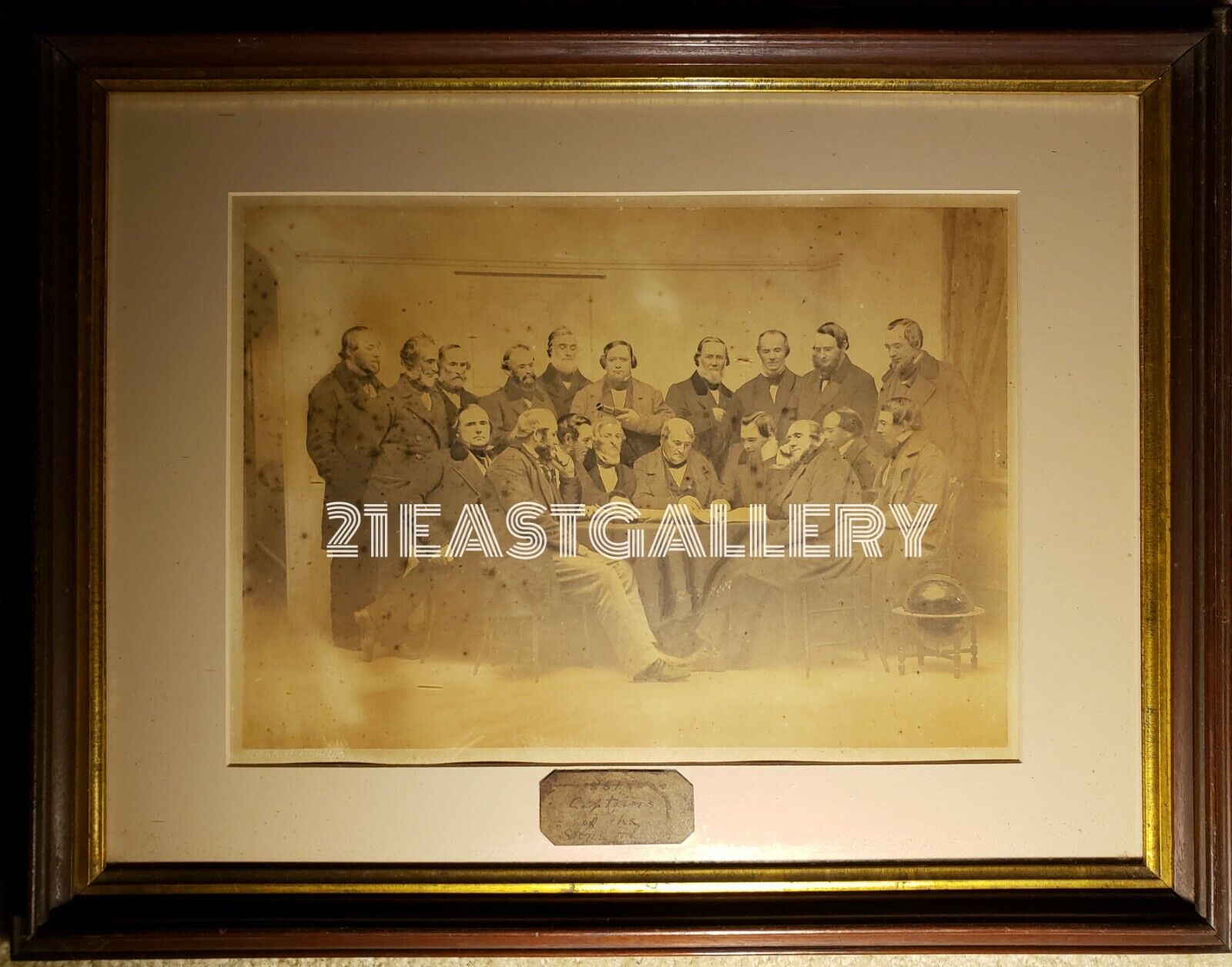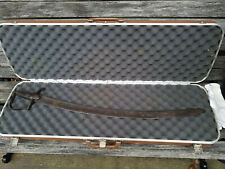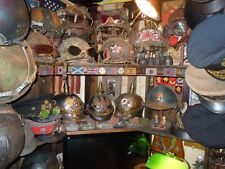CIVIL WAR CAPTAINS OF THE STONE FLEET WHALING SHIPS NEW BEDFORD MA CHARLESTON SC

When you click on links to various merchants on this site and make a purchase, this can result in this site earning a commission. Affiliate programs and affiliations include, but are not limited to, the eBay Partner Network.
CIVIL WAR CAPTAINS OF THE STONE FLEET WHALING SHIPS NEW BEDFORD MA CHARLESTON SC:
$34999.99
An original photograph by the Bierstadt Brothers measuring approximately 11 x 15 1/2 inches behind its original glass and frame measuring approximately 19 x 24 1/4 inches. I am not aware of any other existing period photographs. Last origin was Massachusetts. Please see a related article and wiki below; many others appear online. Thanks for War's 'Stone Fleet' Sailed From New London To Dubious End In South CarolinaThe 19 sea captains of the 'Stone Fleet,' a collection of old ships that were filled with rocks to be sunk in Charleston Harbor as part of the Union blockade of the Confederacy, gathered for a portrait. (/Mystic Seaport)DAVID DRURY, Special to the CourantThe Hartford CourantIn November 1861, New London residents watched with curiosity as teams of oxen hauled wagons loaded with fieldstones through their streets.The stones had been collected from the foundations of farms and old pasture walls in Waterford and surrounding towns. Generations of farmers had used those walls to keep their cattle and livestock from wandering off.Now those stones were to provide a different kind of barrier.When they reached the city wharves the teamsters, singing patriotic songs and with Old Glory waving proudly, worked with dock hands and sailors to load their rocky freight onto waiting ships.Their wooden hulls used to carry blubber and oil from whales, but those days had passed with the advent of steam propulsion and petroleum. The stones were the last cargo these ships would carry.The crews had rigged and readied the ships. Holes were drilled below the water lines in each hull. Plugs were then inserted, to be removed when the aged fleet reached its destination: the harbor of Charleston, S.C., seat of the Southern rebellion.Union military planners believed that by scuttling the ships, they could clog the shipping lanes and bottle up a key Confederate port. The industry-poor South depended on its South Atlantic and Gulf ports to import the weapons, munitions, shoes, clothing and other goods from Europe that it needed to wage the war that had begun seven months before.Devised by Army General-in-Chief Winfield Scott, the Anaconda Plan aimed to use the North's superior naval and material resources to squeeze the life out of the rebellion by seizing the Mississippi River, cutting the Confederacy in two, and blockading the 3,500-mile Southern coastland.Thirteen ships in what became known as the Stone Fleet sailed from New London on Nov. 21, 1861. Twelve others left New Bedford and Boston. The 25 vessels, mostly whalers, were the first of two such fleets that set sail late in the war's first year to toughen the Union blockade and assist in ongoing operations against Confederate coastal defenses.Just one week before, on Nov. 14, a Union flotilla had seized Port Royal Sound, near the Georgia-South Carolina border. Two Connecticut regiments — the 6th and 7th — had stormed ashore to occupy Port Royal's defenses: Fort Walker on Hilton Head Island and Fort Beauregard, both silenced by naval bombardment.It was a notable success in an otherwise lackluster first year of the war for the North.Connecticut and the NavyFrom the earliest days of the Civil War, strategists in the Lincoln administration realized that for the Union to prevail, the Federal Navy had to play a critical role.The blockade had to choke off the South's supply lifeline. Union warships and gunboats had to seize Confederate ports and move large bodies of troops and supplies along coastlines and inland waterways, particularly the Mississippi and Ohio rivers and their various tributaries.Charged with overseeing the effort was Glastonbury native and former Hartford Times editor Gideon Welles,President Lincoln's gruff, hard-working secretary of the navy.Welles and other planners realized that to accomplish its mission, the Navy needed more ships, lots of them. Connecticut, with its long maritime history and established shipyards, became a key supplier, the historic whaling ports of Mystic and New London at the forefront.In 1861, Mystic had three major shipbuilders and several smaller one. It emerged as a leading center for wartime naval construction. Its 50,000 tons of ships surpassed every other Union port except Boston, which was 20 times larger."The Civil War era was the peak of Mystic's long ship-building history. Most of the ships built at Mystic were for troop and supply transport, but several were built and fitted for combat, and a few actually engaged in battle,'' according to an unpublished paper by Brian Stanley, a graduate student in history atCentral Connecticut State University.Steamship construction led the way. The 56 steamships built in Mystic represented, 5 percent of the nation's total, more than Massachusetts and Maine combined. An additional 36 wooden vessels of various size and type were also built.The boom in shipbuilding spawned the growth and development of local subcontractors and suppliers such as the Mystic Iron Works, which in 1862 began fabricating steam boilers and the iron plating the Navy was demanding by late 1861.The iron-clad age had dawned that summer when Confederate naval engineers successfully transformed the burned, wooden hulk of the USS Merrimack into a fearsome, iron-plated commerce raider, the CCS Virginia.To counter the threat, Welles ordered a design competition that resulted in the birth of the famousUSS Monitor, selected by a naval board thanks in large part due to the timely intervention of competing ship designer Cornelius Bushnell of Madison.Bushnell realized that the Monitor design — a "cheesebox on a raft'' with its innovative, rotating gun turret — was superior to his own and lobbied for its selection. In March 1862, the Monitor fought the Virginia to a draw at the Battle ofHampton Roads, ending a serious threat to the Union blockade and signaling the dawn of the modern naval age.Bushnell's own ironclad, the screw-steamer USS Galena, was built in Mystic in just 90 days. Launched in February 1862, it became the Navy's second ironclad and went into action three month later on theJames Riveroutside Richmond. Unfortunately, the ship's iron plating proved inadequate protection against Confederate shore batteries, and its crew sustained heavy casualties. Taken in for repairs, stripped of her plating, the Galena later returned to action as a wooden warship and participated in Admiral Farragut's famous victory at Mobile Bay in 1864.Sunken WhalersA directive from Welles in October 1861 set in motion preparations for the Stone Fleet.A New London businessman, 35-year-old Richard H. Chappell, was charged with finding and outfitting the needed vessels.Chappell had made his mark in New London's whaling industry. Ambitious and resourceful, he had expanded the reach of his firm to include seal hunting in Alaska and the Antarctic and guano collection in the Pacific.Working with agents in New Bedford and Boston, Chappell scoured the New England coastline for ships. In just a few weeks time, 45 vessels, mostly old whalers, were acquired from New York City and various New England ports, with 11 of them coming from New London and others from Mystic.Ships from the initial stone fleet were sunk off Charleston on Dec. 20, 1861 provoking an immediate outcry from the press in South Carolina and across the Atlantic."Shall We Have War With England?'' headlined a Hartford Daily Courant editorial on Jan. 3, 1862. The editorialist argued that Great Britain viewed the American rebellion as an opportunity to weaken a growing commercial power and would seize upon "any pretext'' to tweak the U.S.: "the hostile English press itself is already protesting against such a mode of blockade as injurious to the rights of nations."The second stone fleet sailed December 11. Vessels were sunk off Charleston and Tybee Island, at the mouth of the Savannah River, in early 1862. By then, reports had emerged that that this novel effort to impede Southern blockade-running had achieved, at best, mixed results.As the Courant informed readers on February 15, 1862:"The Sea Ranger which accompanied the stone fleet to Charleston has returned to New London. The Chronicle says the captain brings a report which will somewhat astonish all of us who have fancied that the stone fleet had closed up from navigation the inlets where the hulks have been sunk."The enterprise is pronounced so far a failure that it is still quite an easy matter to sail or steam into or out of the passage in which the stone vessels are placed! They are sunk so far apart that it is easy to steer between them, and some of them lie in such deep soundings that there are six or eight fathoms of water between their rails and the surface."Herman Melville, the great chronicler of the whaling era, mourned what he viewed as a wasteful failure in his poem, "The Stone Fleet." Here are the final stanzas:"To scuttle them — a pirate deed —Sack them, and dismast;They sunk so low, they died so hardBut gurgling dropped at lastTheir ghosts in gales repeatWoe's us, Stone Fleet!"And all for naught. The waters pass—Currents will have their way;Nature is nobody's ally; 'tis well;The harbor is bettered – will stay.A failure and complete,Was your Old Stone Fleet."Source: Hartford Courant TheStone Fleetconsisted of a fleet of aging ships (mostlywhaleships) purchased inNew Bedfordand other New England ports, loaded with stone, and sailed south during theAmerican Civil Warby theUnion Navyfor use asblockships. They were to be deliberately sunk at the entrance ofCharleston Harbor, South Carolina in the hope of obstructingblockade runners, then supplyingConfederateinterests. Although some sank along the way and others were sunk nearTybee Island, Georgia, to serve asbreakwaters, wharves for the landing ofUnion troops, the majority were divided into two lesser fleets. One fleet was sunk to block the south channel offMorris Island, and the other to block the north channel near Rattlesnake Shoals off the present dayIsle of Palmsin what proved to be failed efforts to block access the main shipping channels into Charleston Harbor.[1]HistoryList of ships in the Stone FleetEditAmazon, a 318-tonbark-riggedwhaleship ofFairhaven, Massachusetts, purchased on 30 October 1861 and laden with 325 tons of stone. Sunk as an obstruction atCharleston, South Carolina, on 19 or 20 December 1861.[2]American, a 329-ton bark-rigged whaleship ofEdgartown, Massachusetts, purchased on 1 November 1861. Laden with 300 tons of stone she was sunk in the main channel off Charleston, South Carolina on 20 December 1861.[3]Archer(ship) 322 tons. Purchased by the Navy on 28 October 1861 at a cost of $3,360. Sunk at the entrance to Charleston Harbor on 20 December 1861.[4]Captained by William North.[5]Coreawas a 336-ton armed store ship of theRoyal Navycaptured by fishermen fromNew Bedford, Massachusettsduring theAmerican Revolution, and later served as a whaleship. Reportedly she was not sunk and was in service with the US Army as late as 8 January 1862.[6][7]Cossackwas a 254-ton bark beached onTybee Island, Georgia, to act as a wharf for the landing of troops on 8 December 1861.[8]Courier(ship) 381 tonsFortune(bark) 292 tons,whaleshipFrances Henrietta, was a whaleship from New Bedford, Massachusetts. She was purchased for $4,000 by George Morgan and R.H. Chappell on 19 October 1861. There is evidence she was transferred to the US Army and was still afloat as late as 8 January 1862.[9]Garland, a 243-ton ship from New Bedford, Massachusetts that was captained byRodney French.[5]French had been elected leader of the fleet by his fellow captains and went by the title "Commodore of the stone fleet". TheGarlandwas the last of its fleet to arrive because French took a coastal route while the other ships sailed offshore and held a good wind. Sunk on 19 or 20 December 1861.[10][11]Harvest, was a whaleship that operated out of New England. She was purchased on 21 October 1861, by Morgan and Chappell for $4,000. She arrived off Savannah, Georgia, on 4 December. Records state that she was retained for use as a coal scow.[6][12]Heraldwas a 274-ton whaleship active in the Pacific. Her home port was New Bedford, Massachusetts, owner and master George H. Cash.[13]She was purchased for $4,000 and sunk along with 15 other vessels on 20 December 1861, about four miles south-southeast of Fort Sumter and three miles east-southeast of the light on Morris Island.[14]Kensingtonwas a 357-ton wooden, ship-rigged vessel purchased for $4,000 at New Bedford, Massachusetts, on 28 October 1861. She departed 20 November and arrived Port Royal, South Carolina by 17 December. She was presumably sunk in the main channel leading into Charleston Harbor on 21 December, about four miles south-southeast of Fort Sumter and three miles east-southeast of the light on Morris Island.[14][15]L. C. Richmond, was a 341-ton whaleship that began service in Pacific in 1834. She was purchased for $4,000 and with Captain Martin Malloy, she sailed from New Bedford on 20 November 1861. She was sunk along with 15 other vessels on 20 December, about four miles south-southeast of Fort Sumter and three miles east-southeast of the light on Morris Island.[14][16]Leonidas, was originally built as a whalingbarkof 231 tons, 320 feet long. It was active in the Pacific Ocean in 1849, captained by Captain Swift of New Bedford, Massachusetts. From 1850 to 1854, it was partially owned, and captained by, Benjamin Smith Clark, Jr. It was purchased on 27 October 1861 by the US Navy for $3,050. It sailed from New Bedford in charge of Master John Howland on 20 November,. Exactly one month later, it was intentionally sunk, along with 15 other vessels, about four miles south-southeast of Fort Sumter and three miles east-southeast of the light on Morris Island.[14][17]Lewiswas a sailing ship of 308 tons. It was purchased on October 20m 1861. It ran aground and bilged nearTybee Islandin December 1861. She was 101 feet in length, 26 feet 2 inches in breadth, 13 feet 1 inch in depth of hull, with two decks, three masts, a square stern, no galleries and a billet head.[18][19]Maria Theresa, was a 330-ton ship purchased on 31 October 1861 for $4,000. It was sunk, along with 15 other vessels about four miles south-southeast of Fort Sumter and three miles east-southeast of the light on Morris Island.[14][20]Meteor, a ship purchased atMystic, Connecticuton 4 November 1861, and sunk on 9 January 1862.Phoenix, awhaleshipof 404 tons, sunk as a breakwater for Union troops invading Tybee Island in December 1861.[21]Peter DeMill, was a 300-ton bark purchased on 9 November 1861 and beached withSouth AmericaandCossackon 8 December to serve as a wharf during the landing of Union troops at Tybee Island, Georgia, at the mouth of the Savannah River.[22]Potomac, an old 356 ton whaleship purchased on 1 November 1861 atNantucket, and sunk on 9 January 1862.[23]Rebecca Sims(ship) orRebecca SimmsorRebecca Ann, 400 tons. Built as a general trading ship in 1801, she was eventually refitted as a whaleship, and, by 1850, was sailing from New Bedford.Rebecca Simswas acquired by the Navy at Fairhaven, Massachusetts, on 21 October 1861, stripped of all unnecessary equipment, filled with stone, and, under the command of her previous master, James M. Willis, sent south. On 19–20 December, she and 16 other ships were sunk in the main channel of Charleston Harbor.[24]Robin Hood,East Indiaman(trading vessel), 395 tons, 400 feet. Purchased by the Navy at Mystic, Connecticut, on 20 October 1861. Sunk in the main channel of Charleston, South Carolina, in December 1861.[25]Sarah M. Kemp, was a schooner purchased at Baltimore, Maryland, on 13 August 1861. The ship was to be sunk in the channel leading into the North Carolina sounds; however, no record of her final disposition has been found.[26]South America, a 606-ton whaleship purchased on 9 November 1861 at New London, Connecticut. She was beached withPeter DemillandCossackon 8 December 1861 to serve as a wharf during the landing of troops at Tybee Island, Georgia, at the mouth of the Savannah River.[27]Tenedos(bark), 245 tons, 300 feet, mentioned in Melville's poem. Purchased for the Navy at New London, Connecticut, on 16 October 1861 by George D. Morgan and R. H. Chappell. Under Master O. Sisson she was loaded with blocks of granite from New England and sailed on 20 November 1861. On 19–20 DecemberTenedosand 15 other ships were sunk off the bar of Charleston's main channel.[28]List of ships in the second fleetEditAmerica(ship) 418 tonsDove(bark) 151 tonsEdward(bark) 274 tonsEmerald(ship) 518 tonsIndia, (ship, 366 tons) was purchased at New Bedford, Massachusetts, on 14 November 1861, and sunk in the Maffitt's Channel approach to Charleston on 26 January 1862.[29]Jubilee(bark) 233 tonsMajestic(bark) 297 tonsMarcia(bark) 356 tonsMargaret Scott(bark) 330 tons This ship was bought from the US Marshall in New Bedford, after it had been confiscated as a slave ship. She was sunk 20 January 1862 in Maffitt's Channel in Charleston harbor. A woman namedMargaret Scotthad been executed in 1692 as one of theSalem Witches.[30]Mechanic(ship) 335 tonsMessenger(bark) 216 tonsUSSMontezuma(ship) 424 tonsNewburyport(ship) 341 tonsNew England(ship) 368 tonsNoble(bark) 274 tonsPeri(bark) 261 tons, missing offCharleston, SC, 25 January 1862.Stephen Young(brig) 200 tonsTimor(ship)Valparaiso(ship) 402 tonsWilliam Leewas a bark of 311 tons, built as a whaler in 1836. Mentioned in Melville's poem as theLee.[31]See linksLast edited 2 months agobyAnomieBOTRELATED ARTICLESUSS South America (1861)USS Amazon (1861)USS American (1861)Source: WikipediaOn Jun-12-11 at 15:52:36 PDT, seller added the following information:Sellers: Get your own map of past buyers. Fast. Simple. Posted with Mobile
CIVIL WAR CAPTAINS OF THE STONE FLEET WHALING SHIPS NEW BEDFORD MA CHARLESTON SC:
$34999.99

Related Items:
Antique Original Civil War 1978 Sharps Carbine Firearms by Frank Sellers History
$950000.00
🔥BATTLE LITTLE BIG HORN RELIC INSCRIBED SWORD, George Custer,7th Cavalry,Sioux
$133300.00
Civil War, WWI, WWII, Authentic Military Items & Museum Ouality Reproductions.
$60000.00







